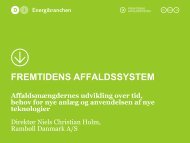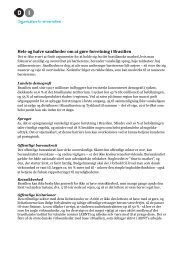Turning waste into climate-friendly energy
Turning waste into climate-friendly energy
Turning waste into climate-friendly energy
You also want an ePaper? Increase the reach of your titles
YUMPU automatically turns print PDFs into web optimized ePapers that Google loves.
exploit the fact that we are in a unique<br />
position in Denmark with a long-term,<br />
stable <strong>energy</strong> policy which provides<br />
every opportunity to focus on green<br />
development. I hope that companies<br />
will strive to manufacture their products<br />
with as little <strong>energy</strong> as possible,<br />
and that they seize every opportunity<br />
for creating green jobs.<br />
If the ambition level of the <strong>energy</strong> agreement<br />
is met, what do you see as the next<br />
step for Denmark’s green industry?<br />
It will not end in 2020. The objective<br />
is for Denmark to become independent<br />
of fossil fuels by 2050. I am<br />
convinced that the rest of the world<br />
will follow our example. We will see<br />
a strongly increasing market for renewable<br />
<strong>energy</strong> and <strong>energy</strong>-efficient<br />
products. An almost boundless market<br />
awaits companies that seize the<br />
opportunity. ·<br />
Source: The Danish<br />
Ministry of Climate and<br />
Energy<br />
”Briefly stated, my most important<br />
political vision is to build a broad political<br />
alliance with companies and<br />
green organisations, so that Denmark<br />
can play a leading role in addressing<br />
<strong>climate</strong> challenges and demonstrate<br />
that there is no contradiction between<br />
a tightly formulated <strong>climate</strong> profile<br />
and increased welfare,” says Climate<br />
and Energy Minister Martin Lidegaard<br />
on the ministry’s website.<br />
THE ENERGY<br />
AGREEMENT IN BRIEF:<br />
On 22 March 2012, the Danish<br />
government entered an <strong>energy</strong><br />
agreement with a broad<br />
coalition in the parliament,<br />
which applies to the period up<br />
to 2020.<br />
ENERGY supplY<br />
– By 2020, 35 percent of Denmark’s<br />
<strong>energy</strong> requirement will<br />
be generated from renewable<br />
sources.<br />
BIOMAss<br />
– The use of coal and gas for heat<br />
and power production will to a<br />
large extend be replaced by biomass.<br />
WINd TuRBINEs<br />
– By 2020, a 600 MW offshore<br />
wind farm will be installed at<br />
Kriegers Flak in the Baltic Sea,<br />
and a 400 MW offshore wind<br />
farm at Horns Rev in the North<br />
Sea. An additional 500 MW of<br />
onshore wind turbines will be<br />
installed up to 2020.<br />
BIOGAs<br />
– The use of biogas is being expanded,<br />
with subsidy being increased.<br />
sOlAR ANd WAvE pOWER<br />
– EUR 13,4 million over four<br />
years is being allocated to support<br />
new renewable <strong>energy</strong> technologies<br />
for electricity production<br />
including solar power and<br />
wave power.<br />
sMART GRId<br />
– The Danish <strong>energy</strong> infrastructure<br />
will be upgraded with new<br />
technologies, to further optimise<br />
the integration of renewable <strong>energy</strong><br />
recourses.<br />
pRIcE<br />
– In 2020, an average household<br />
will pay EUR 175 more annually<br />
for <strong>energy</strong>. Companies will pay<br />
EUR 26,80 more per employee.<br />
In total the agreement will cost<br />
EUR 470 million in 2020.





